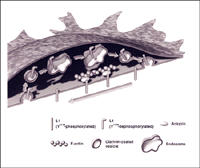  |
 |
 |
Recycling
of the Cell Adhesion Molecule L1 in Axonal Growth Cones
Developmental Brain
Science Group |
 |
 |
| The relationship between axonal elongation and the recycling of the cell adhesion molecule L1 has been elucidated by Dr. Hiroyuki Kamiguchi, a senior researcher of the Developmental Brain Science Group, and Prof. Vance Lemmon of Case Western Reserve University in the USA.
L1 is a membrane protein expressed in growing axons and their tip (growth cone). For axonal elongation (for the growth cone to advance), strong L1-mediated adhesion at the leading edge and deadhesion at the rear of the growth cone are necessary. Our recent study showed that such polarity of cell adhesion is generated and maintained by site-specific endocytosis (intracellular uptake) as well as recycling of L1. Endocytosed L1 at the rear of the growth cone is recycled to the plasma membrane of its leading edge via microtubule-dependent vesicular transportation. Recycled L1 moves retrogradely on the growth cone surface by coupling to the backward flow of actin filaments. Thus, L1 propels the growth cone forward by moving like a caterpillar within the growth cone and along its surface (Figure).
Furthermore, localization of microtubules that transport intracellular L1 is regulated by ligand binding to adhesion molecules expressed on the growth cone (L1, integrins, and cadherins). In this way, growth cones regulate recycling of adhesion molecules in response to changes in the surrounding environment, and this is thought to be a key factor in controlling growth cone motility. |
 |
 |
magnified scene by clicking image
|
Kamiguchi,
H., Lemmon, V. Recycling of the Cell Adhesion Molecule L1 in Axonal Growth Cones.
J. Neurosci. 20, pp3676-3686, May (2000)
|
|
 |
 |
|
|






